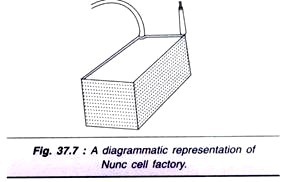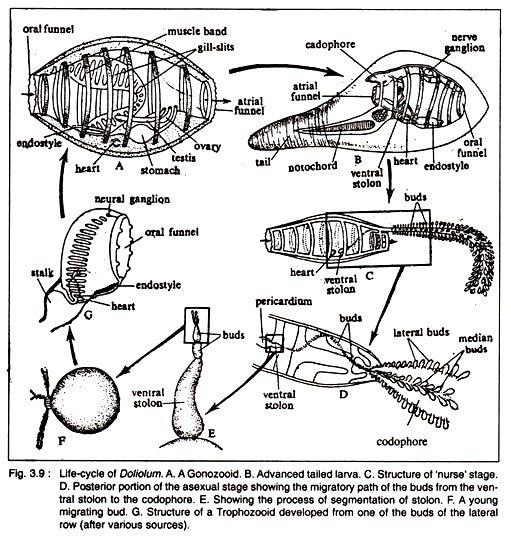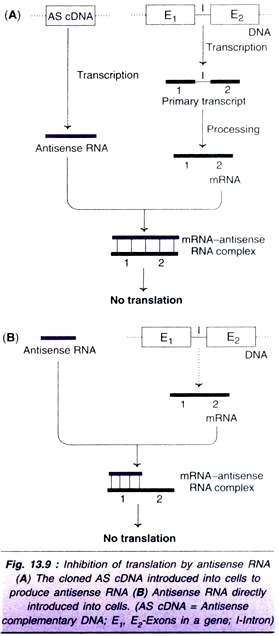In this article we will discuss about the introduction and mechanism of DNA replication.
Introduction to DNA Replication:
While presenting the double helical model of DNA, Watson and Crick had remarked, “It has not escaped our notice that the specific pairing (of bases) we have postulated suggests a possible copying mechanism for the genetic material.”
The complementary nature of the strands suggests that the process of replication must begin with the separation of strands. This idea was proved correct from experiments in which the distribution of labelled and un-labelled DNA strands in the progeny were studied after successive rounds of DNA replication.
Each strand of DNA synthesizes a new strand, so that the resulting DNA has one parental and one new strand. This is called semi-conservative replication because only half of the parental molecule is conserved during replication. Two other modes of DNA replication were suggested by Delbruck (Fig. 14.4).
Conservative method in which each of the two strands of the parent DNA is replicated resulting in two DNA molecules—one double helix with both parental strands, the other with both new strands.
In dispersive replication the double helix breaks at several points forming many pieces. Each piece replicates and the pieces become reconnected at random. Thus two new helices of hybrid molecules are formed in which the parental DNA is distributed all over the four strands.
The final proof that DNA replication indeed takes place semi-conservatively came from experiments performed by Meselson and Stahl. They used a novel technique for determining the density of purified DNA by ultracentrifugation.
By this method they could separate E. coli DNA of different densities. DNA containing the heavy isotope 15N is denser than DNA containing normal nitrogen 14N. E. coli cells were grown in 15N-labelled medium for several generations, so that their chromosomes contained all 15 N-labelled DNA.
A sample of fully labelled E. coli cells was drawn out and made to grow on a medium containing normal nitrogen. After a single replication (one cell generation time), a cell sample was taken out, its DNA was purified and analysed as described below. This was repeated for two successive generations.
The method of separating heavy DNA from light DNA is called density gradient equilibrium centrifugation. Purified DNA is dissolved in a concentrated solution of caesium chloride (8.8 M CsCl in water) and centrifuged in a transparent quartz tube for 5-8 hours at very high speed. When centrifugal forces are applied, CsCl being denser than water tends to sediment towards the outside of the tube.
This tendency to sediment is opposed by diffusion, and after several hours a state of equilibrium is reached. The concentration distribution of CsCl in the tube is stabilized with high density at the bottom of the tube and lowest at the top, and all grades of density in between.
The DNA molecules in the tube come to rest in that region of the CsCl gradient that corresponds to their own density, and form a sharp band. The exact position of the DNA band in the density gradient is determined by using ultraviolet light to photograph the tube, since DNA absorbs ultraviolet light and CsCl does not. From the position of the DNA band the density of the DNA molecules present in the band can be calculated.
It was found that heavy DNA fully labelled with 15N formed a band at the bottom of the CsCl solution. The DNA isolated from cells grown in low density (14N) medium for one generation formed a band in an intermediate position. Whereas light DNA from low density medium after two cell generation’s time formed a band at the top (Fig. 14.5).
This shows that after one complete round of DNA synthesis, all the new DNA molecules are hybrids, consisting of an old heavy (15N) DNA strand and one new light (14N) DNA strand. The data provided evidence that DNA had replicated semi-conservatively.
Experiments similar to Meselson and Stahl’s were performed on eukaryotic cells in which bromodeoxyuridine (BudR), a specific density label for DNA was used by Filner (1965) in Nicotiana tabacum and by Sueoka (1961) in Chlamydomonas.
BudR being an analogue of thymidine becomes incorporated into DNA by replacing thymidine. The results showed that after one cycle of DNA replication in BudR, all the resulting DNA is of hybrid density. Thus eukaryotic DNA replication is also semi-conservative.
Using the technique of autoradiography, J.H. Taylor (1957) studied the pattern of segregation of whole chromatids in chromosomes at successive mitoses after labelling. The results have been interpreted to demonstrate semi-conservative replication in eukaryotic chromosomes.
Root tips of the broad been (Vicia faba) were grown in a solution containing tritiated thymidine (i.e. thymidine labelled with 3H called tritium, a radioactive isotope of hydrogen). The actively dividing cells in the root tip incorporated radioactive thymidine into the DNA in chromosome. The cells were allowed to divide for many generations in this medium, after which they were transferred to a medium containing normal thymidine.
Here the cells were allowed to remain just long enough to undergo one cell division. The presence of radioactive isotope in chromatids was detected by autoradiography. Chromosome spreads are prepared on a slide which is then covered with a liquid emulsion of silver bromide.
The slides are then stored in the dark for 6-8 weeks. During this time the decay of the radioactive isotope will reduce the silver bromide grains lying directly above them. The slides are then developed much like a photograph negative. The emulsion is washed out except for dark spots at places where reduced silver grains are present.
The results were clear and conclusive. Cells harvested after several rounds of replication in solution containing radioactive thymidine had both chromatids labelled (Fig. 14.6).
But in cells which had divided once in normal thymidine, only one chromatid of each chromosome was labelled, the other chromatid was un-labelled. At each successive generation, the number of labelled chromatids in daughter cells was halved. The segregation of chromatids is therefore semi-conservative.
Molecular Mechanism of DNA Replication:
By late 1950s it became generally accepted that DNA replicates semi-conservatively. Studies on molecular mechanisms underlying replication were initiated only after Arthur Romberg in 1957 discovered the enzyme which is involved in DNA replication. This enzyme is today known as DNA polymerase I or pol I.
Romberg was awarded Nobel Prize in 1959. Later on two other enzymes DNA polymerase II and DNA polymerase III (pol II and pol III) having similar properties as pol I were isolated. It appears that mainly DNA polymerase III is involved in DNA replication. DNA polymerase I fills gaps in DNA and also functions in repair of DNA. The function of DNA polymerase II is still not well understood.
DNA Polymerase I:
Kornberg isolated this enzyme from living E. coli cells and used it for DNA replication in vitro. Since E. coli cells divide rapidly, their DNA duplicating once in every 20 minutes, it is a suitable material for isolating the enzyme in high concentration.
Romberg achieved in vitro DNA synthesis using DNA polymerase I and the following components:
(1) All the four deoxynucleotides in the tri-phosphorylated form i.e. dATP, dGTP, dCTP, dTTP;
(2) Mg++;
(3) A primer strand of DNA (or RNA) with a free 3′ OH end (primer DNA is a partially denatured double stranded DNA to which new bases are added and also serves as template for the sequence of bases added).
The DNA polymerase I catalyses the addition of single nucleotide units’ to the free 3′-hydroxyl end of the primer DNA strand. The chain is synthesised in the 5′-3′ direction. The primer DNA is itself a short strand of DNA or a double strand with a nick in one strand exposing a free 3′-hydroxyl group and a 5′-phosphate group. The primer strand is base-paired with a long DNA strand that serves as the template. The name template-primer is now given to this structure.
DNA polymerase I isolated from E. coli has a single polypeptide chain of about 4000 amino acids and a molecular weight of 109,000. The enzyme molecule is roughly spherical in shape with a diameter of about 6.5 nm. In the purified state one molecule of the enzyme, at 37°C can add about 1,000 nucleotides per minute to a growing DNA chain.
To show that the DNA synthesised in vitro by the purified DNA polymerase I has the same base sequence as the DNA used in the primer and template strand, Romberg devised a method known as nearest-neighbour base frequency analysis. This method determines the frequency with which any two bases occur as adjacent or nearest neighbours in the DNA strand.
The in vitro system containing all the four tri-phosphorylated nucleotides has one of the nucleotides labelled with 32P. Out of the three phosphates in the triphosphate linked to 5′ carbon of the sugar, the innermost or alpha phosphate group has the 32 P label.
This phosphate is not eliminated as pyrophosphate in the reaction. But when DNA synthesis occurs, it forms second linkage with the carbon at position 3′ of the neighbouring nucleotide in the newly synthesised DNA chain.
The DNA is then degraded by the endonuclease enzyme spleen phosphodiesterase which breaks DNA into single nucleotides at the 5′ phosphate-sugar linkages only. The 32P containing alpha phosphoric acid remains attached to the 3′ carbon of the nearest neighbour nucleotide to the one on which it entered the DNA strand.
The 32P contents of all the four nucleotides are measured and found proportional to the frequencies with which they occurred next to the nucleotide that was labelled. The experiment is repeated three more times each time labelling the triphosphate of a different nucleotide.
Kornberg’s experiments established beyond doubt that DNA polymerase I lead to in vitro DNA synthesis. However, in 1967 J. Cairns provided evidence that this may not always be so.
He isolated a mutant strain of E. coli known as pol Al which was lacking in DNA polymerase, but still was able to grow and replicate its DNA normally. When these cells were exposed to UV and X-radiation, it was found that they could not repair damage to their DNA. From this it follows that DNA polymerase I is a repair enzyme and may not be responsible for replication.
Later on DNA polymerase I was shown to have exonuclease activity in both 3′ to 5′ and 5′ to 3′ directions (Fig. 14.7 A). It performs exonuclease activity mainly for removing a wrongly placed nucleotide, as will be explained later.
Further experiments proved that the DNA polymerase I molecule actually consists of two subunits: a larger polypeptide chain with molecular weight of about 76,000 Daltons; a smaller chain with molecular weight of 36,000 Daltons. The two subunits dissociate on treatment with proteolytic enzymes. The larger subunit possesses the repair and 3′ to 5′ exonuclease activities; the smaller subunit has 5′ to 3′ exonuclease activity.
DNA Polymerase II and III:
From the pol Al mutants of E. coli two other enzymes were isolated namely DNA polymerase II and DNA polymerase III (pol II and pol III). The wild type E. coli cells contain all the three polymerase enzymes i.e. pol I, II and III which are coded for by structural genes pol A, B, and C.
The exact function of DNA polymerase II in replication is not known with certainty. It has exonuclease activity in 3′ to 5′ direction. Mutants defective in pol II (pol B) have been isolated but they are phenotypically indistinguishable from the wild type. It is, therefore, likely that pol II is not necessary for replication.
DNA polymerase III was discovered in 1972 by T. Kornberg (son of Arthur Kornberg) and Gefter. This is the enzyme most actively involved in DNA replication. It also performs exonuclease activity in both 3′ to 5′ and 5′ to 3′ directions. Later on kornberg showed that this enzyme is actually a dimer of pol III and pol III* and is known as DNA polymerase III* (pol three star).
It requires a protein, co-polymerase III* (copol III*) to function (Fig. 14.7B). Like pol I, DNA polymerase III* replicates a template-primer strand of DNA. It appears therefore that pol III*-copol III* complex along with ATP, a DNA template and an RNA primer are necessary to initiate replication.
Bends in DNA:
There is evidence from X-ray diffraction studies and from pattern of nuclease digestion (cuts produced by DNAase I and II and micro-coccal nuclease) that a structure in DNA repeats itself after 10 or 20 base pairs. Crick and Klug (1975) suggested that at these points the double helix is bent or ‘kinked’. Between the kinks the DNA is straight.
One base pair at the kink is un-stacked from the adjacent one while pairing of the strands is undisturbed. This produces a bend in the double helix towards the side of the minor groove. According to Selsing et al. (1979) there might be alternate stretches of A and B forms of DNA between the bends.
Supercoiled DNA:
The supercoiling of DNA complexed with protein in eukaryotic chromatin is described (the solenoidal super-helix of chromosomes). Here, a different type of supercoiling in some forms of prokaryotic and organelle DNA is discussed. In the closed circular molecules of DNA, such as in mouse polyoma virus, human papilloma virus and mitochondrial DNA, the double helix itself becomes coiled into a new helical form called supercoiled DNA.
It is also observed that covalently closed circular molecules of double helical DNA are usually under-wound. They are said to be negatively supercoiled and in a relaxed state. The forces which confer stability on the double helix probably lead to the formation of supercoils in under-wound DNA.
A recently described enzyme DNA gyrase is said to maintain the negatively supercoiled conformation of DNA. In vitro the enzyme is shown in convert under-wound, closed circular DNA into super coiled form in the presence of ATP. It has also been suggested that DNA gyrase is involved in replication, transcription and recombinational activities of DNA.
The enzyme DNA gyrase consists of two subunits, the nal A protein and the cou protein; the first (nal A) subunit performs a nicking-closing function resulting in relaxation of supercoiled DNA. This activity is inhibited by nalidixic acid and oxolinic acid. The activity of the cou subunit though not well understood is inhibited by novobiocin.
Besides DNA gyrase, a number of enzymes which perform similar activities have been recently detected. Since they all produce inter-conversions in the topological isomers of DNA, Wang and Liu (1978) have called them DNA topoisomerases.



